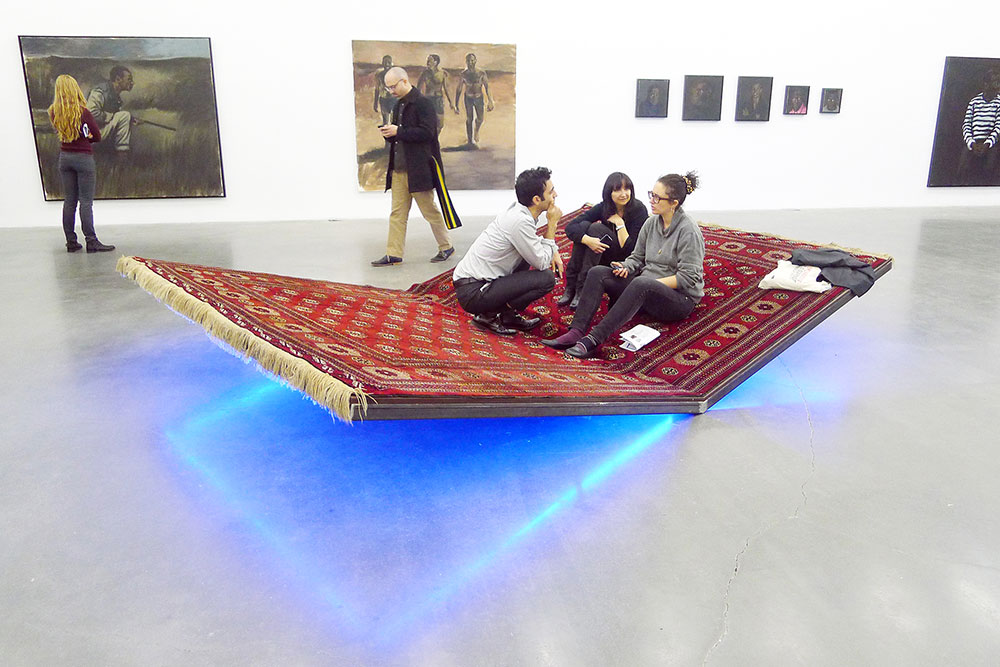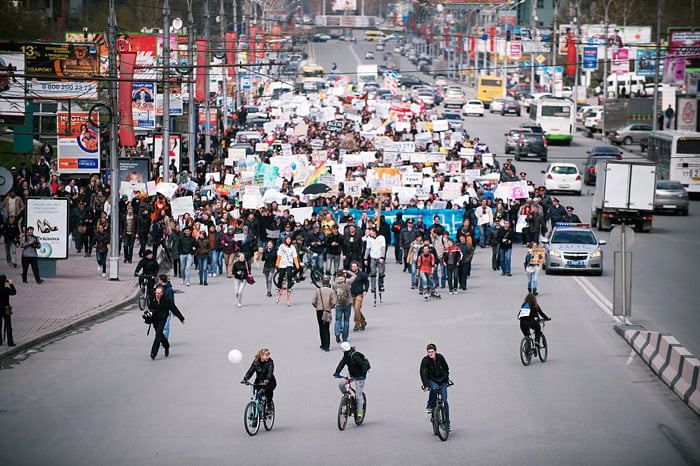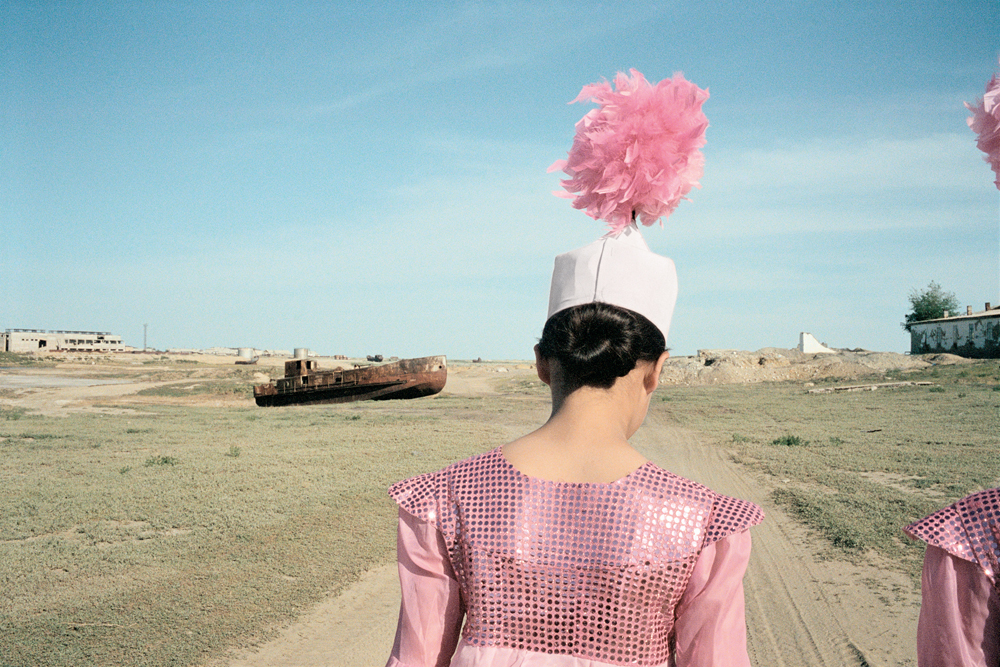Wall to wall: meet Slavs and Tatars, the art collective slaying stereotypes from Berlin to Beijing

Since 2006, Slavs and Tatars have been challenging simplistic attitudes towards the history and culture of the region “east of the Berlin Wall and west of the Great Wall of China”. Dina Akhmadeeva interviewed them about their intellectually engaged but playful work
One of Slavs and Tatars’ aphorisms — “Dig the booty of monoglots, but marry, my child, a polyglot” — was up on the screen of my laptop as I browsed through the collective’s vast back catalogue. I had paused on the image of the work — a vacuum-formed plastic painted sign in three languages, initially appealing to speakers of Persian, Russian, and English — to read the Russian, only to find that it was gibberish, the English phrase transliterated in Cyrillic script. The man sitting next to me, meanwhile, started laughing at the very same sign, and proceeded to explain to me that he was amused by the very same English phrase transliterated into nonsense Persian. Slavs and Tatars were able to bring together a speaker of Russian and a speaker of Persian to share the same joke on the basis of the distinct cultural heritage of each.
By asserting such moments of connection through their work, Slavs and Tatars are highlighting overlooked relationships between regions, languages, ethnicities, alphabets and religions that have come to be artificially disentangled from one another through our own discursive boundaries. Eastern Europe is over here, the Middle East is there, Central Asia is over there and the Caucasus next to it. In opting for a more syncretic approach, the collective has been able to recuperate these oft-forgotten histories of exchange, co-existence and, at times, conflict across the entire region “east of the Berlin Wall and west of the Great Wall of China”. Slavs and Tatars can in one breath mention intermingled narratives among Russia, Central Asia, the Caucasus, Iran and eastern Europe. In Dig the Booty, for example, the co-existence of Persian, Cyrillic and Latin scripts in fact draws upon the history of one place — Azerbaijan — and the complex processes of transliteration Azeri went through during the 20th century.
Straddling the line between pop culture and academic endeavours, in 2009 Slavs and Tatars developed a performance entitled Hymns of No Resistance, adapting cult pop songs “to address issues of territorial dispute, language, and geopolitics within greater Eurasia”. Michael Sembello’s She’s a Maniac from Flashdance becomes She’s Armenian, tracing the experience of the Armenian diaspora. Let’s Call the Whole Thing Off is co-opted into a narrative of contested territories and renamed cities: “You like Nagorno and I like Karabagh/ You like Konigsberg and I like Kaliningrad/ Nagorno, Karabagh, Konigsberg, Kaliningrad/ Let’s call the whole thing off.” Stuck in the Middle with You becomes Stuck in Ossetia with You: “I don’t know why I’m in Tskhinvali tonight/ I got the feeling that something ain’t right/ I’m so scared in case I’m caught in a raid/ And I’m wondering what plans history’s made/ Russians to the North of me/ NATO to the West, here I am/ Stuck in Ossetia with you.” It’s heavy stuff, set to saccharine and familiar music. While the musical backing may border on the trite and familiar, the subject matter may not be strikingly obvious — be they the experiences of the Armenian diaspora, the recent conflict between Russia and Georgia, or the language politics of Abkhaz.
The collective is committed to “resuscitating” marginalised histories and narratives — that which has been left out or neglected. Thus their work is often part-history lesson — the history you did not know existed. As one member of Slavs and Tatars explains: “There’s an urgency to the very term ‘resuscitation’: the need to assess and re-assess certain histories and narratives at risk of being eclipsed by the singular, black and white amnesia of our present […] When there tends to be a consensus about something, it’s the best indication of a blind spot, one which we can burrow ourselves into and explore further.”
This generosity often involves welcoming the audience into their world of tangled references, languages, religions and ethnicities. Their PrayWay (2012) set up a carpeted seating area in the New Museum in New York that was a cross between a rahlé — a holy book stand — and a takht – a space for sitting and conversing in teahouses. Sitting cross-legged on the installation, Slavs and Tatars recuperated some of the informal atmosphere of a teahouse as they conversed with their audience members. Slavs and Tatars also chose this teahouse format when they curated the Marker section of Art Dubai 2014, for the first time devoted to the art of the Caucasus and Central Asia. The artworks became the setting for social interaction about ideas of faith, identity and nationhood through artworks of two regions too often left on the margins of both contemporary Middle Eastern and eastern European art.
The collective regularly delivers lecture-performances as part of the group’s endeavour, and during St. Petersburg’s Manifesta last year addressed the audience on Russian Orientalism under the playful title Tranny Tease. Their Regions d’Etre (2012) took the form of a jungle gym for the audience to climb among their Nations mirror-paintings, a series of playful slogans such as “What’s the Plan, Uzbekistan?” in fluorescent green. In Idź na Wschód! [Go East!] (2009), Slavs and Tatars took on the role of tour organisers for their audience on a day trip to Bohoniki and Kruszyniany, two Tatar villages on the eastern edge of Poland, to explore the Muslim history and customs of Polish Tatars.
Why, you might ask, is their work relevant? What can work about teahouses, linguistics, watermelons, failed transliteration efforts, monobrows, dubbing, phonemes and kebabs made by a collective that presents its work across Europe, the US, the Middle East and eastern Europe tell us about Eurasia’s regions? Well, everything. Rather than be seen as monolithic entities — eastern Europe superficially defined by characteristics we might understand as closer to “Slav”, and Central Asia as closer to “Tatar” — each nook of the vast region is recharacterised through a lens of cosmopolitanism, ethnic, religious and linguistic difference, co-habitation and diversity. Slavs and Tatars encourage their audience to look beyond the centre to the margins and demand that the margins affects the way in which we understand the centre.
The movement of people and things, and languages, ethnicities and religions thrown into contact with one another, is something that has characterised the Silk Road, the famous route across Central Asia, the Caucasus, Russia and Europe, for hundreds of years. As one member of Slavs and Tatars tells me, “If our region — the Caucasus and Central Asia — has too often been considered remote or obscure, then at the very least we can console ourselves with the thought that this has been an exclusively 20th century phenomenon.” Perhaps there is in fact a lot to learn from the region. Or, in the words of their own exhortation from the 2011 Melanchotopia project, “Keep your majorities close but your minorities closer.”







